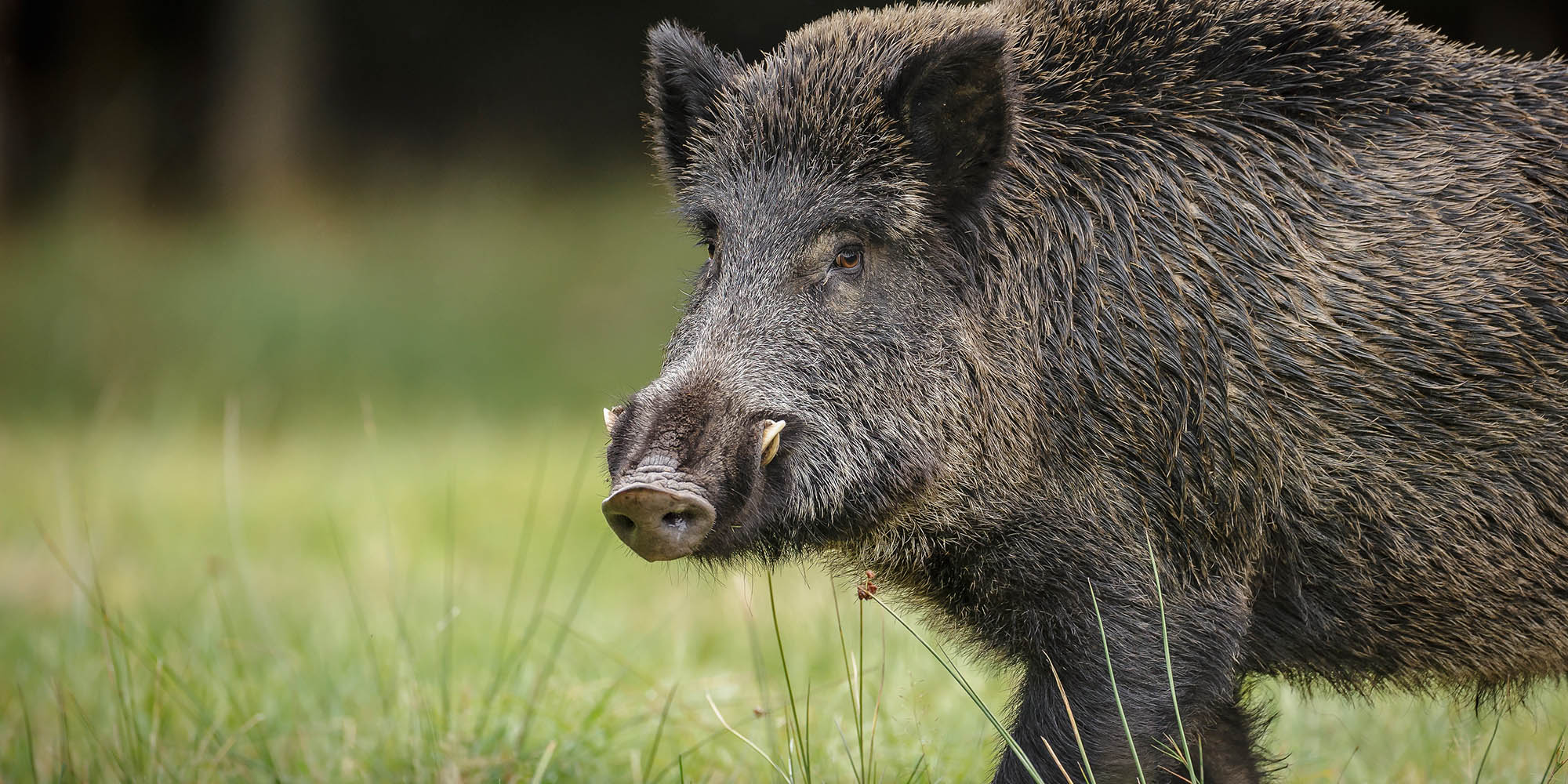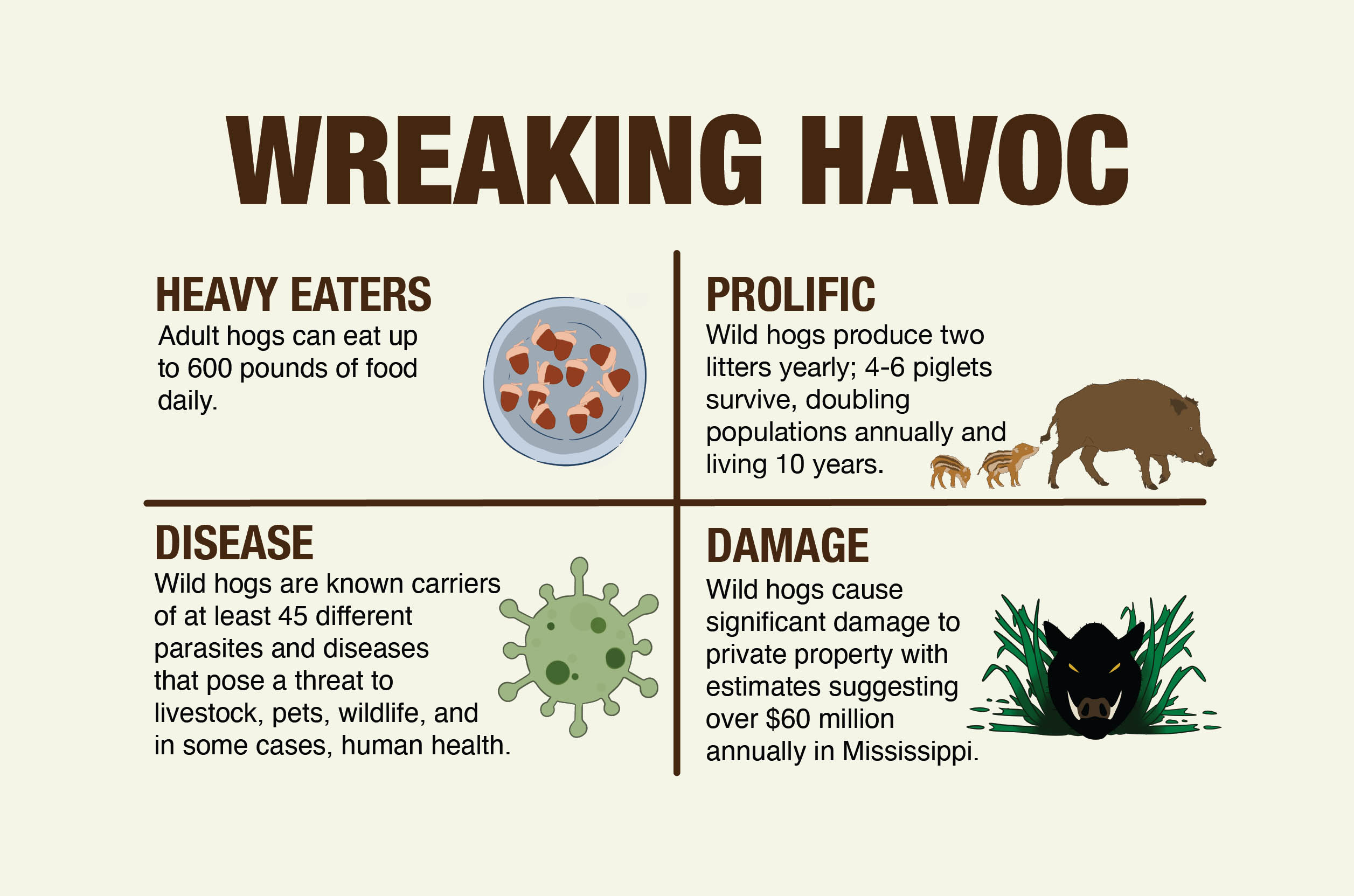Wild pigs are expanding their range across the Southeastern United States, impacting farmland and ecosystems and causing significant agricultural and infrastructure losses. But what drives their movement? In Mississippi State's Mississippi Agricultural and Forestry Experiment Station (MAFES) and Forest and Wildlife Research Center, researchers use computer programming software to understand how these animals navigate their environment. By analyzing how social ties and landscapes influence their decisions, scientists gain insights that could help landowners and trappers manage wild pig populations more effectively.
Understanding what drives animal movements and determines their ranges is a central challenge in ecology. However, traditional modeling approaches often struggle to capture the complexity of these behaviors. Scientists are addressing this gap using a novel process-based modeling approach that combines step selection functions with individual-based models. Step selection functions are models that analyze animal movement by comparing the environmental attributes of observed movements between two locations to those of other possible movements. This flexible method allows scientists to analyze the environmental and social factors influencing animal movement.
By applying this technique, researchers can uncover the underlying drivers of space use patterns, offering valuable insights into the behavior of invasive species, like wild pigs.
Dr. Garrett Street, principal investigator and associate professor in wildlife, fisheries, and aquaculture, collaborated with researchers from the University of Sheffield and the Swansea University Lab for Animal Movement to conduct a series of predictive models to run simulations of wild pig movement and landscape use. The team opportunistically trapped and GPS-collared 16 adult pigs in the Greenwood area.
Over 60 days, movements were analyzed concerning various landscape types using the USDA National Agricultural Statistics Service Cropland Data Layer. GPS data from 12 of the 16 collared pigs, six females and six males, were placed into R and Python, two coding programs, for a more in-depth investigation. The four pigs whose data were not chosen were excluded due to insufficient movement or incomplete GPS data and were not included in the final analysis.
The scientists knew wild pig behavior was driven by various landscape types, but they wanted to explore further how the spatial configuration of the landscape and social interactions influenced behavioral decisions. Scientists anticipated that pigs may select their movements based on a combination of land cover types and the previous movements of other pigs, while also avoiding areas that have been heavily used. While this was supported by the research, some surprising details were also revealed.
"One of the biggest things that we immediately saw was that the landscape matters. Pigs do not thermoregulate themselves well, so they use habitat to help keep themselves cool. To do this, they need shade, water sources, and space for wallowing. All these things are needed in the landscape," Street said. "We expected to see this, but what was surprising is the amount of differing characteristics within a landscape of importance to hogs."
In terms of habitat preferences, wild pigs in Mississippi and across the Southeast are often associated with bottomland hardwood forests. These areas provide key resources like water and abundant food, including hard mast from acorns and soft mast from understory plants like blackberries. Agricultural fields, particularly those with corn and soybeans, are also highly attractive to pigs, contributing to the significant crop damage they cause. Based on these known preferences, researchers expected to see pigs favoring these habitats. However, recent findings suggest that the pigs' choices are more nuanced.
Rather than simply seeking out bottomland hardwoods or agricultural fields, pigs seem to prefer landscapes that offer a mix of these elements. A field purely of corn might seem attractive, but the team found that pigs were more drawn toward areas where food resources, like cornfields, are interspersed with other habitat types, like hardwood forests and water sources. This mosaic of resources creates a more attractive and functional space, offering everything the animals need within a relatively small area. The team also found that socialization played a large role in movement patterns.
"We found that, in terms of deciding movement, the landscape often mattered less than the social aspect. When we mapped their movements, we were able to better predict where the animals would be and how much space they would use based less on the landscape and the habitat structures, and more on if there were other pigs present," Street said. "It wasn't just whether there were other pigs in the area. It was dependent on how many other pigs were on the landscape. There was an attractive force if there were a smaller number of pigs, such as five, and a repelling force if there were more pigs present, like 30."
These findings have significant implications for management strategies, particularly for trapping efforts. Effective control may require considering not just the presence of a specific habitat type, but the overall composition and structure of the landscape.
"I would love to do more research to investigate the correlation between landscape composition and wild pig preference. I would also love to work alongside professional pig trappers and learn where they put their traps in a landscape. We could contrast that with predictions from our research and collaborate on understanding wild pig movements. That is the dream, working alongside trappers to improve what we all know about these animals and how we do things. Us learning from them, them learning from us," Street said.
Completely removing wild pigs from the landscape may be unrealistic in regions like the Southeast, where their populations are well established. However, reducing their numbers can minimize the destruction they cause. This research aims to support those efforts by providing insights into better removal strategies. While trapping remains essential, the research also explores alternative approaches, such as modifying the landscape to make it less attractive to pigs. Instead of merely reacting to pig presence, proactive habitat management could reduce their impact.
"If we can manage the landscape to make it less attractive for swine, we can have an indirect approach to managing their populations. We can manage the habitat in a way that naturally draws wild pigs away from where we don't want them to be," Street said. "We can couple this indirect approach with direct management approaches, such as trapping and hunting. One of the most important things I hope can be done with this research is providing inference about direct and indirect management simultaneously. I think that the indirect management component is the next natural step to combating the damage that wild pigs cause."
While this research focused on wild pigs, particularly across the Southeast, methods used within the data analysis of this project have been applied to other species, such as white-tailed deer.
"This is why I focus so heavily on the methods themselves—because the method is just a tool. If we can develop a robust tool, it can be applied to various situations and species. We are now exploring how these tools might be used for management of Chronic Wasting Disease, a deadly neurological disease that affects deer, elk, moose, and more," Street said. "I've also been thinking about how we can apply these methods to systems outside of Mississippi. For example, I'm particularly interested in using them to study moose movements in Ontario, where I gained a lot of my early research experience. Applying these tools in Ontario could provide valuable insights for meaningful forest management for wildlife communities."
Street hopes the tools and findings from this research can be used by everyone and encourages them to explore whether these methods can be used beyond wild pigs and white-tailed deer.
"This research is incredibly gratifying to me. One of the best aspects of it is knowing that these general tools can be applied anywhere. I hope that other researchers, landowners, and wildlife managers will take an interest in using these methods. Not everyone enjoys the mathematics, statistics, and programming involved in developing these tools as much as I do. However, I believe the value of these tools is clear. Landowners, state biologists, federal biologists, and conservationists can all benefit from these products and consider applying them to other systems," Street said. "While I consider myself more of an analyst, I deeply value collaboration with wildlife conservationists and managers. I bring the tools, the theory, and the technical skills to the table, while they contribute their system-specific knowledge, policy insights, and on-the-ground experience. Together, we can make these tools work for effective and meaningful wildlife management and conservation."
This research was done in collaboration with the University of Sheffield and Swansea University Lab for Animal Movement. The USDA Agricultural Research Service and the Mississippi Agricultural and Forestry Experiment Station funded this research.
If we can manage the landscape to make it less attractive for swine, we can have an indirect approach to managing their populations. We can manage the habitat in a way that naturally draws wild pigs away from where we don't want them to be.
Dr. Garrett Street


